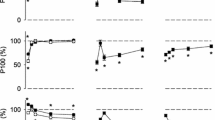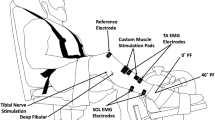Abstract
The separate effects of negative (eccentric) and positive (concentric) work on stimulated and voluntary isometric contraction of the triceps surae were studied in five healthy male subjects following the performance of boxstepping for 1 h with a constant leg lead.
The results showed unequivocally that the long-lasting muscle weakness which arises from box-stepping was due to the negative component of the work. The maximal twitch (\(P_{ t_{_0 } } \)) and tetanic (P 0) tensions at 10, 20, 50 and 100 Hz were markedly reduced in the leading (“negative”) leg, which was constantly required to absorb the force of body weight as the subject returned from box to floor, whereas the trailing (“positive”) leg which lifted body weight from floor to box was relatively unaffected. The decreases in\(P_{ t_{_0 } } \) andP 0 at 20 Hz in the “negative” leg following work were 38 N and 765 N (25% and 55%) respectively and recovery was slow (>20 h). A 2 min “fatigue” test reflected the changes inP 0; a reduction of absolute force was only seen in the negative leg though the relative (%) decline in tension was the same in both legs and its rate did not differ significantly following exercise from control conditions, which suggests the muscles were weaker but not more fatiguable following exercise. At submaximal voltages of stimulation muscle tensions at 20 and 50 Hz were enhanced in the “positive” leg but depressed in the “negative” leg, the relative (but not absolute) loss of force being greater at 20 Hz than 50 Hz which gave rise to long-lasting fall in the 20/50 tension ratio. The loss of high frequency (50 Hz) force was associated with changes in MVC: MVC (N)=507+0.937P 0 (N);r=+0.846.
It was suggested that repeated stretching of the triceps surae muscles during the eccentric phase of work in the “negative” leg could affect the efficacy of the contractile machinery directly and may cause actual muscle damage. The subjects complained of muscle soreness for 5–7 days after the experiments.
Similar content being viewed by others
References
Abbott BC, Aubert XM, Hill AV (1951) The absorption of work by a single twitch or short tetanus. Proc Roy Soc B 139:86–104
Asmussen E (1952) Positive and negative muscular work. Acta Physiol Scand 28:364–382
Burke RE, Levine DN, Tsairis P, Zajac FE (1973) Physiological types and histochemical profiles in motor units of the cat gastrocnemius. J Physiol 234:723–748
Davies CTM (1979) The effects of different levels of heat production induced by diathermy and eccentric work on thermoregulation during exercise at a given skin temperature. Eur J Appl Physiol 40:171–180
Davies CTM, White MJ (1981) Muscle weakness following dynamic exercise in man. J Appl Physiol in press
Edwards RHT, Hill DK, Jones DA, Merton PA (1977) Fatigue of long duration on human skeletal muscle after exercise. J Physiol 272:769–778
Margaria R (1968) Positive and negative work performances and their efficiencies in human locomotion. Int Z Angew Physiol Ein Arbeitsphysiol 25:339–351
Nielsen B, Nielsen M (1965) On the regulation of sweat secretion in exercise. Acta Physiol Scand 64:314–322
Nielsen B (1969) Thermoregulation in rest and exercise. Acta Physiol Scand (Suppl):323
Viitasalo JT, Komi PV (1978) Force-time characteristics and fibre composition in human leg extensor muscles. Eur J Appl Physiol 40:7–15
Author information
Authors and Affiliations
Rights and permissions
About this article
Cite this article
Davies, C.T.M., White, M.J. Muscle weakness following eccentric work in man. Pflugers Arch. 392, 168–171 (1981). https://doi.org/10.1007/BF00581267
Received:
Accepted:
Issue Date:
DOI: https://doi.org/10.1007/BF00581267




